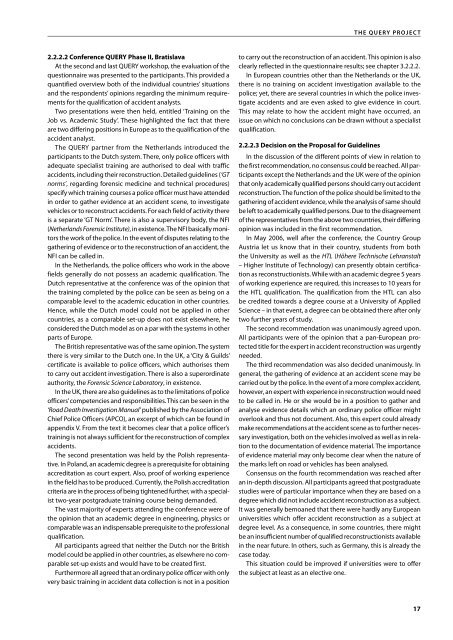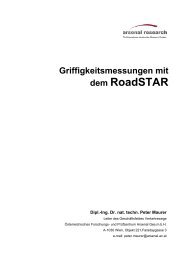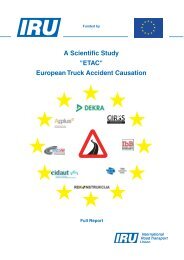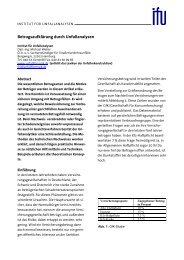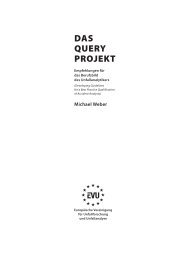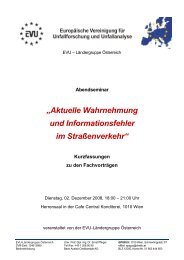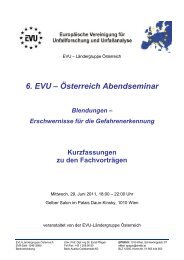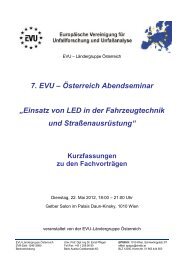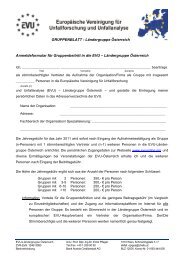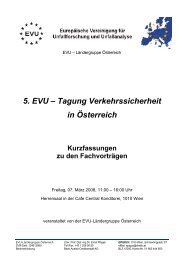THE QUERY PROJECT - European Commission - Europa
THE QUERY PROJECT - European Commission - Europa
THE QUERY PROJECT - European Commission - Europa
Create successful ePaper yourself
Turn your PDF publications into a flip-book with our unique Google optimized e-Paper software.
. . . Conference <strong>QUERY</strong> Phase II, Bratislava<br />
At the second and last <strong>QUERY</strong> workshop, the evaluation of the<br />
questionnaire was presented to the participants. This provided a<br />
quantified overview both of the individual countries’ situations<br />
and the respondents’ opinions regarding the minimum requirements<br />
for the qualification of accident analysts.<br />
Two presentations were then held, entitled ‘Training on the<br />
Job vs. Academic Study’. These highlighted the fact that there<br />
are two differing positions in Europe as to the qualification of the<br />
accident analyst.<br />
The <strong>QUERY</strong> partner from the Netherlands introduced the<br />
participants to the Dutch system. There, only police officers with<br />
adequate specialist training are authorised to deal with traffic<br />
accidents, including their reconstruction. Detailed guidelines (‘GT<br />
norms’, regarding forensic medicine and technical procedures)<br />
specify which training courses a police officer must have attended<br />
in order to gather evidence at an accident scene, to investigate<br />
vehicles or to reconstruct accidents. For each field of activity there<br />
is a separate ‘GT Norm’. There is also a supervisory body, the NFI<br />
(Netherlands Forensic Institute), in existence. The NFI basically monitors<br />
the work of the police. In the event of disputes relating to the<br />
gathering of evidence or to the reconstruction of an accident, the<br />
NFI can be called in.<br />
In the Netherlands, the police officers who work in the above<br />
fields generally do not possess an academic qualification. The<br />
Dutch representative at the conference was of the opinion that<br />
the training completed by the police can be seen as being on a<br />
comparable level to the academic education in other countries.<br />
Hence, while the Dutch model could not be applied in other<br />
countries, as a comparable set-up does not exist elsewhere, he<br />
considered the Dutch model as on a par with the systems in other<br />
parts of Europe.<br />
The British representative was of the same opinion. The system<br />
there is very similar to the Dutch one. In the UK, a ‘City & Guilds’<br />
certificate is available to police officers, which authorises them<br />
to carry out accident investigation. There is also a superordinate<br />
authority, the Forensic Science Laboratory, in existence.<br />
In the UK, there are also guidelines as to the limitations of police<br />
officers’ competencies and responsibilities. This can be seen in the<br />
‘Road Death Investigation Manual’ published by the Association of<br />
Chief Police Officers (APCO), an excerpt of which can be found in<br />
appendix V. From the text it becomes clear that a police officer’s<br />
training is not always sufficient for the reconstruction of complex<br />
accidents.<br />
The second presentation was held by the Polish representative.<br />
In Poland, an academic degree is a prerequisite for obtaining<br />
accreditation as court expert. Also, proof of working experience<br />
in the field has to be produced. Currently, the Polish accreditation<br />
criteria are in the process of being tightened further, with a specialist<br />
two-year postgraduate training course being demanded.<br />
The vast majority of experts attending the conference were of<br />
the opinion that an academic degree in engineering, physics or<br />
comparable was an indispensable prerequisite to the professional<br />
qualification.<br />
All participants agreed that neither the Dutch nor the British<br />
model could be applied in other countries, as elsewhere no comparable<br />
set-up exists and would have to be created first.<br />
Furthermore all agreed that an ordinary police officer with only<br />
very basic training in accident data collection is not in a position<br />
t h E Q u E R y P R o j E C t<br />
to carry out the reconstruction of an accident. This opinion is also<br />
clearly reflected in the questionnaire results; see chapter 3.2.2.2.<br />
In <strong>European</strong> countries other than the Netherlands or the UK,<br />
there is no training on accident investigation available to the<br />
police; yet, there are several countries in which the police investigate<br />
accidents and are even asked to give evidence in court.<br />
This may relate to how the accident might have occurred, an<br />
issue on which no conclusions can be drawn without a specialist<br />
qualification.<br />
. . . Decision on the Proposal for Guidelines<br />
In the discussion of the different points of view in relation to<br />
the first recommendation, no consensus could be reached. All participants<br />
except the Netherlands and the UK were of the opinion<br />
that only academically qualified persons should carry out accident<br />
reconstruction. The function of the police should be limited to the<br />
gathering of accident evidence, while the analysis of same should<br />
be left to academically qualified persons. Due to the disagreement<br />
of the representatives from the above two countries, their differing<br />
opinion was included in the first recommendation.<br />
In May 2006, well after the conference, the Country Group<br />
Austria let us know that in their country, students from both<br />
the University as well as the HTL (Höhere Technische Lehranstalt<br />
– Higher Institute of Technology) can presently obtain certification<br />
as reconstructionists. While with an academic degree 5 years<br />
of working experience are required, this increases to 10 years for<br />
the HTL qualification. The qualification from the HTL can also<br />
be credited towards a degree course at a University of Applied<br />
Science – in that event, a degree can be obtained there after only<br />
two further years of study.<br />
The second recommendation was unanimously agreed upon.<br />
All participants were of the opinion that a pan-<strong>European</strong> protected<br />
title for the expert in accident reconstruction was urgently<br />
needed.<br />
The third recommendation was also decided unanimously. In<br />
general, the gathering of evidence at an accident scene may be<br />
carried out by the police. In the event of a more complex accident,<br />
however, an expert with experience in reconstruction would need<br />
to be called in. He or she would be in a position to gather and<br />
analyse evidence details which an ordinary police officer might<br />
overlook and thus not document. Also, this expert could already<br />
make recommendations at the accident scene as to further necessary<br />
investigation, both on the vehicles involved as well as in relation<br />
to the documentation of evidence material. The importance<br />
of evidence material may only become clear when the nature of<br />
the marks left on road or vehicles has been analysed.<br />
Consensus on the fourth recommendation was reached after<br />
an in-depth discussion. All participants agreed that postgraduate<br />
studies were of particular importance when they are based on a<br />
degree which did not include accident reconstruction as a subject.<br />
It was generally bemoaned that there were hardly any <strong>European</strong><br />
universities which offer accident reconstruction as a subject at<br />
degree level. As a consequence, in some countries, there might<br />
be an insufficient number of qualified reconstructionists available<br />
in the near future. In others, such as Germany, this is already the<br />
case today.<br />
This situation could be improved if universities were to offer<br />
the subject at least as an elective one.<br />
1


